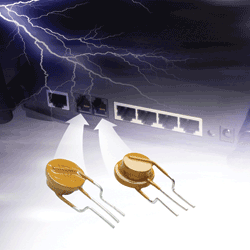Devices integrate PPTCs and MOVs to thwart damage caused by overcurrent and overvoltage incidents in telecom CPE
BY PHILIPPE DI FULVIO
Tyco Electronics
Menlo Park, CA
http://www.circuitprotection.com
The widespread adaptation of VoIP gateways in homes and enterprise environments has resulted in increasingly stringent safety requirements for customer premise equipment (CPE). CPE for telecom must meet the requirements of UL60950, TIA-968-A, and ITU-T K.21 as specified by network operators and consumer safety agencies.

Devices integrating a PPTC and MOV can help improve protection from damage caused by overcurrent and overvoltage in telecom systems.
Central-office and network equipment must comply with regional safety agency standards such as Telcordia GR-1089 and ITU-T Recommendation K.20, which mandate overvoltage and overcurrent protection to ensure reliable equipment performance and personnel safety. Power-surge damage to telecommunications and VoIP equipment may occur as a result of lightning and ESD surges, power contact, and induction with ac lines.
Low-cost resettable circuit protection—in the form of an integrated overcurrent and overvoltage component—can help equipment providers comply with applicable safety standards and performance criteria.
Reducing component count
Lightning, inductive-load switching, or capacitor-bank switching may cause transient overvoltage conditions. Metal oxide varistors (MOVs) are typically used for transient overvoltage suppression, but in many line-voltage applications there is also the potential for a sustained abnormal overvoltage/limited-current condition that may cause the MOV to go into thermal runaway, resulting in overheating, outgassing, and possibly fire.
Protecting the MOV from thermal overdissipation is frequently accomplished with a thermal cut-off (TCO) device placed in series with the MOV. A typical line-voltage-transient protection scheme may also incorporate an overcurrent protection element, such as a fuse, to help protect the system from damage caused by an overload condition that exceeds a predetermined level.
Helping to prevent damage
An integrated-device approach can help manufacturers of industrial equipment — including PLC network adapters, cell phone chargers, power supplies, and lighting systems — meet industry test requirements, reduce component count, and improve equipment reliability. Such a device combines a polymeric positive temperature coefficient (PPTC) overcurrent component with an MOV component into one thermally protected device, to provide resettable current limiting for overcurrent conditions and voltage clamping during overvoltage events.
Under normal operating conditions the ac line voltage applied to an MOV is not expected to exceed the device’s maximum ac root mean voltage (Vac rms) rating and — provided that the transient energy does not exceed the MOV’s maximum rating — short-duration transient events are clamped to a suitable voltage level. However, a sustained abnormal overvoltage/limited current condition, such as a loss of neutral, may cause the MOV to go into thermal runaway.
Standard unprotected MOVs are typically rated to 275 Vac rms for a universal input voltage. In a loss of neutral condition they may overheat with negative consequences, even if a fuse or power resistor is upstream.
With such unlimited current, the unprotected MOV will first fall to low impedance of a few ohms, but due to the high amount of energy present it is likely to rupture. If devices are placed on the ac-line return path to limit current, these may also overheat due to the MOV’s failure.
With the integrated solution, the PPTC element helps prevent thermal runaway, maintaining varistor surface temperature at less than 150C and preventing the device from reaching unsafe temperatures caused by overvoltage transients. This helps manufacturers comply with IEC 60950 and IEC 60335 and helps equipment remain operational after specified lightning tests according to IEC 61000-4-5. Also, because the PPTC element is in series with the MOV, no additional overcurrent protection is required.
How it works
Although the ac line voltage applied to an MOV is not generally expected to exceed the device’s maximum continuous operating voltage rating, overvoltage transients may occur that exceed these limits. Integrating PPTC technology with the MOV improves overcurrent and thermal protection under conditions where the MOV is exposed to prolonged continuous overvoltage events.
In the event of an overvoltage transient, such as a loss of neutral event, the PPTC element heats up, trips, and goes into a high-resistance state, helping to reduce the risk of MOV device failure. ■
Advertisement
Learn more about TE Connectivity





